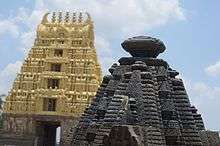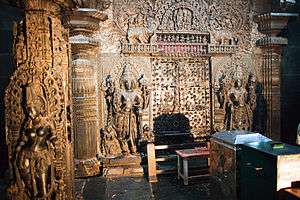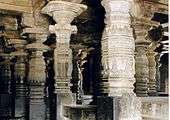Chennakesava Temple

.jpg)

The Chennakeshava Temple, (Kannada: ಶ್ರೀ ಚೆನ್ನಕೇಶವ ದೇವಸ್ಥಾನ) originally called Vijayanarayana Temple (Kannada: ವಿಜಯನಾರಾಯಣ ದೇವಸ್ಥಾನ), was built on the banks of the Yagachi River in Belur, by the Hoysala King Vishnuvardhana. Belur, which was an early Hoysala capital, is in the Hassan district of Karnataka state, India. It is 40 km from Hassan city and 220 km from Bangalore. Chennakesava (lit, "handsome Kesava") is a form of the Hindu god Vishnu. Belur is well known for its marvelous temples built during the rule of the Hoysala dynasty, making it and nearby Halebidu favored tourist destinations in Karnataka state. These temple complexes have been proposed to be listed under UNESCO World Heritage Sites.
History

The temple was commissioned by King Vishnuvardhana in 1117 AD. Scholars are divided about the reasons for the construction of the temple. The military successes of Vishnuvardhana is considered a probable reason.[1] Some scholars believe Vishnuvardhana commissioned the temple to surpass his overlord, King Vikramaditya VI of the Western Chalukya Empire (who ruled from Basavakalyan), after his initial military victories against the Chalukyas.[2] According to another theory, Vishnuvardhana was celebrating his famous victory against the Chola dynasty of Tamil country in the battle of Talakad (1116 AD), which resulted in the annexation of Gangavadi (modern southern Karnataka) by the Hoysalas.[3] Another theory points to Vishnuvardhana's conversion from Jainism to Vaishnavism (a sect of Hinduism) after coming under the influence of saint Ramanujacharya, considering this is a predominantly Vaishnava temple in sculptural iconography.[4] The Hoysalas employed many noted architects and artisans who developed a new architectural tradition, which art critic Adam Hardy called the Karnata Dravida tradition.[5] In all 118 inscriptions have been recovered from the temple complex, covering the period 1117 AD to the 18th century, giving historians details of the artists employed, grants made to the temple and renovations committed during later times.
Temple complex


The main entrance to the complex is crowned by a Rajagopura (superstructure over entrance) built during the days of the Vijayanagar empire.[6] Within the complex, the Chennakesava temple is at the centre, facing east, and is flanked by the Kappe Channigraya temple on its right, and a small Sowmyanayaki (form of the goddess Lakshmi) temple set slightly back. On its left, also set slightly back is the Ranganayaki (Andal) temple. Two main sthambha (pillar) exist here. The pillar facing the main temple, the Garuda (eagle) sthambha was erected in the Vijayanagar period while the pillar on the right, the Deepa sthambha (pillar with lamp) dates from the Hoysala period. This is the first great Hoysala temple, though according to the art critic and historian Settar, the artistic idiom and signature is still Western Chalukyan. Hence, the over-decoration which is seen in later Hoysala temples (including the Hoysaleswara temple at Halebidu and the Keshava temple at Somanathapura) is not visible here. According to Settar, during later years, the Hoysala art took an inclination towards craftsmanship, with a weakness for minutiae.[2] The Chennakesava temple has three entrances and their doorways have decorated sculptures called dvarapalaka (doorkeepers) on either side. While the Kappe Channigraya temple is smaller than the Chennakesava temple, it is architecturally significant, though it lacks any sculptural features. The Kappe Chennigraya temple became a dvikuta (two shrined temple) with the later addition of a shrine to its original plan. The original shrine has a star-shaped plan while the additional shrine is a simple square. The image inside is also that of Kesava ( a form of the god Krishna) and was commissioned by Shantala Devi, the noted queen of King Vishnuvardhana.[2]
Temple plan

The building material used in the Chennakesava temple is chloritic schist, more commonly known as (soapstone) or potstone,[7][8] and is essentially a simple Hoysala plan built with extraordinary detail. What differentiates this temple from other Hoysala temples of the same plan is the unusually large size of the basic parts of the temple.[9][10][11] The temple is a ekakuta vimana design (single shrine) of 10.5 m by 10.5 m size. A large vestibule connects the shrine to the mandapa (hall) which is one of the main attractions of the temple. The mandapa has 60 "bays" (compartments).[12] The superstructure (tower or Shikhara) on top of the vimana has been lost over time. The temple is built on a jagati (platform for circumabulation).[13][14] There is one flight of steps leading to the jagati and another flight of steps to the mantapa. The jagati provides the devotee the opportunity to do a pradakshina (circumambulation) around the temple before entering it. The jagati carefully follows the staggered square design of the mantapa[15] and the star shape of the shrine. The mantapa here was originally an open one. A visitor would have been able to see the ornate pillars of the open mantapa from the platform. According to art critic Gerard Foekema, the mantapa is perhaps the most magnificent one in all of medieval India.[16] The open mantapa was converted into a closed one after about fifty years, during the Hoysala rule. This was done by erecting walls with pierced window screens. The window screens are on top of 2 m high walls. There are twenty eight such windows, with star-shaped perforations and bands of foliage, figures and mythological subjects. On one such screen, King Vishnuvardhana and his queen Shanatala Devi are depicted. Another icon depicts the king in a standing posture.[17]
Shrine

The vimana (shrine) is at the back of the mantapa. Each side of the vimana measures 10.5 m and has five vertical sections. Each vertical section comprises a large double storeyed niche in the centre and two heavy pillar-like sections on either side. The two pillar-like sections adjoining the niche are rotated about their vertical axis to produce a star-shaped plan for the shrine.[18] The pillar-like section and the niche bear many ornate sculptures, belonging to an earlier style. There are some sixty large sculptures of deities from both Vaishnava and Shaiva faiths. From the shape of the vimana it has been inferred that the tower above it would have been of the Bhumija style when it existed and not the regular star shaped tower that followed the shape of the vimana. The Bhumija towers, which are intact on the miniature shrines at the entrance of the hall are actually a type of nagara (North Indian) tower, being curvilinear in shape.[19] This shape of tower is quite uncommon in pure dravidian architecture. The shrine has a life size (about 6 ft) image of Keshava (a form of Vishnu) with four hands. Each hand holds an attribute; the discus (chakra), the mace (gadha), the lotus-flower (padma) and the conch (Shanka), in clockwise direction. The entrance to the shrine is flanked by life size sculptures of door guardians (dvarapalaka).

Pillars and Sculptures

The pillars inside the hall are an attraction and the most popular one is the Narasimha pillar which at one time could have revolved on its ball bearings.[20] According to the historian Kamath, there is a rich diversity about the pillar styles here. While all the forty eight pillars are unique and the many ceiling sections are well decorated, nothing surpasses the finish of the four central pillars and the ceiling they support. These pillars may have been hand chiseled while the others were lathe turned.[21] All of these four pillars bear madanikas (Salabhanjika–celestial damsels). There are 42 of them in the temple complex, one each on the four central pillars inside the hall and the remaining 38 are outside, between the eaves on the outer walls of the hall.[22] They are also called shilabalika and represent the ideal female form. They are depicted in various forms, such as dancers, musicians and drummers, and are rarely erotic in nature. Some madanikas that usually are popular with tourists are the Darpana Sundari (lit,"beauty with mirror"), "The lady with the parrot", "The huntress" and Bhasma mohini.[20] Other interesting sculptures inside the mantapa are Sthamba buttalika (pillar with an image in frieze) which is more in the Chola style indicating that the Hoysalas may have employed Chola craftsman along with locals. These images have less decor than regular Hoysala sculptures, the mohini pillar being an example.[2]

At the base of the outer walls are friezes[23] of charging elephants (six hundred and fifty of them) which symbolize stability and strength, above which are lions which symbolize courage, and further up are horses which symbolize speed. Above the horses are panels with floral designs signifying beauty above which are sculptures with depictions from the Hindu epics, the Ramayana and the Mahabharata. According to Kamath, this style of articulation is called horizontal treatment with friezes.[24] Hoysala artisans preferred to be discreet about eroticism, mingling miniature erotic sculptures in not so conspicuous places such as recesses and niches. Sculptures depict daily life in a broad sense.[2]

The doorways to the mantapa have on both sides an image of "Sala" slaying a lion.[25] Historian Kamath claims this is a tiger. Though Sala is known to be the founder of the Hoysala empire in popular legend, there is no support for this theory from scholars such as D.M. Durrett, B.R. Joshi and Hayavadhana Rao. Normally this image is placed on the sukanasi (tower over the vestibule) adjoining the main tower. Legend has it that Sala killed the lion (or tiger) which was about to pounce on a meditating saint who sought Sala's help. Some historians speculate that the legend may have gained importance after King Vishnuvardhana's victory over the Chola dynasty in the battle of Talakad, the tiger being the royal emblem of the Cholas.[26][27]
Other important sculptures here are the Narasimha (a form of Vishnu) image in the south western corner, Gajasurasamhara (Hindu god Shiva slaying demon in form of elephant) on the western side, the winged Garuda, a consort of the god Vishnu standing facing the temple, dancing Kali (a form of Durga), a seated Ganesha (son of Shiva), a boy with an umbrella and a king (the Vamana Avatar or incarnation of Vishnu), Ravana shaking Mount Kailash, Durga slaying demon Mahishasura, standing Brahma, Varaha (avatar of Vishnu), Shiva dancing on demon (Andhakasura), Bhairava (avatar of Shiva), Pandava prince Arjuna shooting a fish seeing its reflection, and the Sun god Surya. The sculptural style of the wall images bear similarities with wall sculptures in contemporary temples of northern Karnataka and adjacent Maharashtra.
Artists
The Hoysala artists, unlike other medieval artists, preferred to sign their work in the form of inscriptions. In doing so, they sometimes revealed details about themselves, their families, guilds and place of origin.[2] Stone inscriptions and copper plate inscriptions provide more information about them. Ruvari Mallitamma was a prolific artist to whom more than 40 sculptures are attributed.[28] Dasoja and his son Chavana who were from Balligavi in modern Shimoga district made important contributions. Chavana is credited with the work on five madanikas and Dasoja accomplished four of them. Malliyanna and Nagoja created birds and animals in their sculptures. Artists such as Chikkahampa and Malloja are credited with some of the sculptures in the mantapa.[29]
Gallery
_at_the_Chennakeshava_temple_in_Belur.jpg) A temple tank (Kalyani or Pushkarni) at the Chennakeshava temple complex, Belur
A temple tank (Kalyani or Pushkarni) at the Chennakeshava temple complex, Belur The Ranganayaki temple, a minor shrine in the Chennakeshava temple complex, Belur
The Ranganayaki temple, a minor shrine in the Chennakeshava temple complex, Belur The Soumyanayaki temple, a minor shrine in the Chennakeshava temple complex, Belur
The Soumyanayaki temple, a minor shrine in the Chennakeshava temple complex, Belur The compact and ornate Veeranarayana temple, a minor shrine in the Chennakeshava temple complex, Belur
The compact and ornate Veeranarayana temple, a minor shrine in the Chennakeshava temple complex, Belur- The Kappe Chennigaraya temple, built by Queen Shantala Devi in 1117 AD, a minor shrine in the Chennakeshava temple complex, Belur
 Decorative turret in relief art at Chennakeshava temple, Belur
Decorative turret in relief art at Chennakeshava temple, Belur Decorative panel comprising miniature towers (aedicule) and Hindu deities in relief below eves at Chennakeshava temple, Belur
Decorative panel comprising miniature towers (aedicule) and Hindu deities in relief below eves at Chennakeshava temple, Belur_in_the_background.jpg)
- Shrine wall relief at Chennakeshava temple, Belur
- Decorative frieze on moldings at Chennakeshava temple. Belur
- Relief sculpture of the Hindu god Narasimha at the Chennakeshava temple, Belur
 The Courtyard of Chennakesava Temple, Belur
The Courtyard of Chennakesava Temple, Belur Ornated lintel with the Makara (mythical beasts) on either side
Ornated lintel with the Makara (mythical beasts) on either side Madanikas below the eaves
Madanikas below the eaves Decorated ceiling in the mantaapa of the Chennakesava Temple, Belur
Decorated ceiling in the mantaapa of the Chennakesava Temple, Belur Carvings on the Outer walls of the temple.
Carvings on the Outer walls of the temple.
Notes
- ↑ Foekema (1996), p. 47
- 1 2 3 4 5 6 Professor S. Settar. "Hoysala Heritage". Frontline, Volume 20 - Issue 08, April 12–25, 2003. Frontline, From the publishers of the Hindu. Retrieved 2006-11-12.
- ↑ Kamath (2001), p. 124
- ↑ However, according to Professor Settar, contemporary records do not support this theory Professor S. Settar. "Hoysala Heritage". Frontline, Volume 20 - Issue 08, April 12–25, 2003. Frontline, From the publishers of the Hindu. Retrieved 2006-11-12.
- ↑ Hardy (1995), pp. 6–7
- ↑ Kamath (2001), p. 183
- ↑ Kamath (2001), p. 136
- ↑ Quote:"The Western Chalukya carvings were done on green schist (soapstone). This technique was adopted by the Hoysalas too" Takeo Kamiya. "Architecture of the Indian subcontinent, 20 September 1996". Gerard da Cunha-Architecture Autonomous, Bardez, Goa, India. Retrieved 2006-11-12.
- ↑ Quote:"While it is not very obvious from looking at the temple, its architectural plan is actually a new kind of nagara (North Indian) design popular in contemporary designs in the imperial city of Basavakalyan", Gerard Foekema; Jayashree Kannikeswaran. "The Templenet Encyclopedia - Temples of Karnataka-Chennakesava Temple at Belur". TempleNet. Retrieved 2006-11-12.
- ↑ Quote:"According to art critic Percy Brown, the Hoysala architectural style is distinctively Dravidian", Kamath (2001), p. 134
- ↑ Art critic Adam Hardy calls it Karnata Dravida style", Adam Hardy. "Indian Temple Architecture: Form and Transformation--The Karnata Dravida Tradition 7th to 13th Centuries,1995". Vedams Books from India, Vedams eBooks (P) Ltd. Retrieved 2006-11-12.
- ↑ Quote:"A bay is a square or rectangular compartment in the hall", Foekema (1996), p. 93
- ↑ Quote:"The jagati serves as a pradakshinapatha or path for circumambulation, as the shrine has no such arrangement", Kamath (2001), p. 135
- ↑ Quote:"This platform is unique to the Hoysala designs", Arthikaje, Mangalore. "Religion, Literature, Art and Architecture in Hoysala Empire". © 1998-00 OurKarnataka.Com, Inc. Archived from the original on 2006-11-04. Retrieved 2006-11-12.
- ↑ Quote:"The Hoysala plan for open mantapa is almost always staggered square. This results in many projections and recesses", Foekema (1996), p. 22
- ↑ Foekema (1996), p. 48
- ↑ Quote:"These pierced windows are very commonly found in earlier Western Chalukya temples also", Kamath (2001), p. 116
- ↑ Foekema (1996), p. 49
- ↑ Foekema (1996), p. 50
- 1 2 Shruti Nanavaty. "Belur - A Temple Retreat". TempleNet. Retrieved 2006-11-12.
- ↑ Quote:"This is a common feature of Western Chalukya-Hoysala temples", Kamath (2001), p. 117
- ↑ Quote:"An eave is a projecting roof, overhanging the wall" Foekema (1996), p. 93
- ↑ Quote:"A frieze is a rectangular band decorated with sculptures", Foekema (1996), p. 93
- ↑ Quote:"A prominent feature in Hoysala temples", Kamath 2001, p. 134
- ↑ Foekema (1996), p. 22
- ↑ C. Hayavadhana Rao, J. D. M. Derrett, B. R Joshi surmise that Sala was a mythical founder of the empire; Kamath (2001), p. 123
- ↑ Arthikaje, Mangalore. "The Hoysalas and their contributions". © 1998-00 OurKarnataka.Com, Inc. Archived from the original on 2006-11-04. Retrieved 2006-11-12.
- ↑ He signed his work as Malli or just Ma (according to the Mysore archaeological reports) U.B. Githa; Research associate. "Here, the past unfolds itself in all its glory & might - Hoyasala architecture in Somanathapura". Deccan Herald, Tuesday, May 11, 2004. Chitralakshana. Archived from the original on 2006-10-05. Retrieved 2006-11-12.
- ↑ Dr. Jyotsna Kamath, November 04,2006. "Hoysala Temples of Belur". © 1996-2006 Kamat's Potpourri. Retrieved 2006-11-12.
References
- Kamath, Suryanath U:A Concise History of Karnataka from pre-historic times to the present, 2001, Jupiter books, MCC, Bangalore (Reprinted 2002) OCLC: 7796041.
- Foekema, Gerard:A Complete Guide to Hoysala Temples, Abhinav, 1996 ISBN 81-7017-345-0
- Sastri, Nilakanta K.A.: A History of South India, From Prehistoric times to fall of Vijayanagar, 1955, OUP, New Delhi (Reprinted 2002), ISBN 0-19-560686-8
- Hardy, Adam (1995) [1995]. Indian Temple Architecture: Form and Transformation-The Karnata Dravida Tradition 7th to 13th Centuries. Abhinav Publications. ISBN 81-7017-312-4.
- "Hoysala art and architecture Dr. Jyotsna Kamat". Retrieved 2006-11-12.
- "Hoysala Heritage". Retrieved 2006-11-12.
- "TempleNet, Chennakesava Temple at Belur". Retrieved 2006-11-12.
- "TempleNet, Belur - A Temple Retreat". Retrieved 2006-11-12.
- "Hoyasala architecture in Somanathapura". Archived from the original on 2006-10-05. Retrieved 2006-11-12.
- "History of Karnataka, Arthikaje". Archived from the original on 2006-11-04. Retrieved 2006-11-12.
- "Architecture of the Indian Subcontinent, Takeyo Kamiya". Retrieved 2006-11-12.
- "An article by U.B.Githa, Hoyasala architecture in Somanathapura". Archived from the original on 2006-10-05. Retrieved 2006-11-12.
- "Indian Temple Architecture: Form and Transformation--The Karnata Dravida Tradition 7th to 13th Centuries/Adam Hardy". Retrieved 2006-11-12.
External links
| Wikimedia Commons has media related to Chennakesava Temple. |
- Sri.Channakeshava Temple
- Chennakeshava Temple
- Photo of Gopura - Chennakeshava Temple
- Plan of temple
- detailed Information on complex
- explanation of temple and its architecture in the order as a person would walk around it
Coordinates: 13°9′46.3″N 75°51′38.0″E / 13.162861°N 75.860556°E